The AMD Zen and Ryzen 7 Review: A Deep Dive on 1800X, 1700X and 1700
by Ian Cutress on March 2, 2017 9:00 AM ESTBenchmarking Performance: CPU System Tests
Our first set of tests is our general system tests. These set of tests are meant to emulate more about what people usually do on a system, like opening large files or processing small stacks of data. This is a bit different to our office testing, which uses more industry standard benchmarks, and a few of the benchmarks here are relatively new and different.
PDF Opening
First up is a self-penned test using a monstrous PDF we once received in advance of attending an event. While the PDF was only a single page, it had so many high-quality layers embedded it was taking north of 15 seconds to open and to gain control on the mid-range notebook I was using at the time. This put it as a great candidate for our 'let's open an obnoxious PDF' test. Here we use Adobe Reader DC, and disable all the update functionality within. The benchmark sets the screen to 1080p, opens the PDF to in fit-to-screen mode, and measures the time from sending the command to open the PDF until it is fully displayed and the user can take control of the software again. The test is repeated ten times, and the average time taken. Results are in milliseconds.
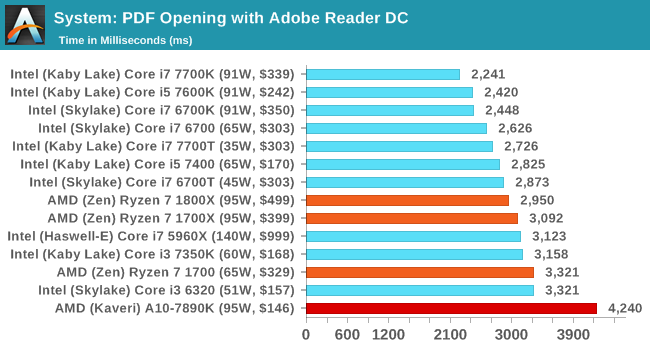
FCAT Processing
One of the more interesting workloads that has crossed our desks in recent quarters is FCAT - the tool we use to measure stuttering in gaming due to dropped or runt frames. The FCAT process requires enabling a color-based overlay onto a game, recording the gameplay, and then parsing the video file through the analysis software. The software is mostly single-threaded, however because the video is basically in a raw format, the file size is large and requires moving a lot of data around. For our test, we take a 90-second clip of the Rise of the Tomb Raider benchmark running on a GTX 980 Ti at 1440p, which comes in around 21 GB, and measure the time it takes to process through the visual analysis tool.
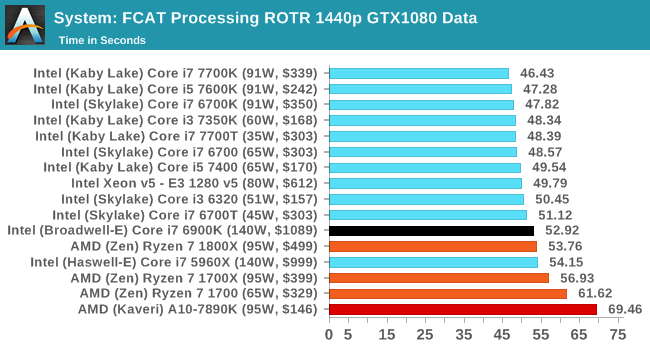
3D Particle Movement v2.1
This is the latest version of the self-penned 3DPM benchmark. The goal of 3DPM is to simulate semi-optimized scientific algorithms taken directly from my doctorate thesis. Version 2.1 improves over 2.0 by passing the main particle structs by reference rather than by value, and decreasing the amount of double->float->double recasts the compiler was adding in. It affords a ~25% speed-up over v2.0, which means new data.
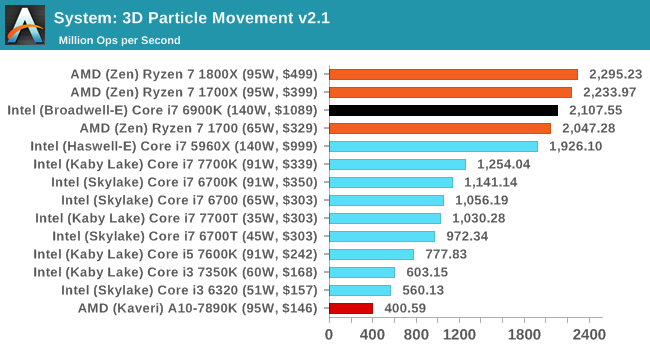
DigiCortex 1.16
Despite being a couple of years old, the DigiCortex software is a pet project for the visualization of neuron and synapse activity in the brain. The software comes with a variety of benchmark modes, and we take the small benchmark which runs a 32k neuron/1.8B synapse simulation. The results on the output are given as a fraction of whether the system can simulate in real-time, so anything above a value of one is suitable for real-time work. The benchmark offers a 'no firing synapse' mode, which in essence detects DRAM and bus speed, however we take the firing mode which adds CPU work with every firing.
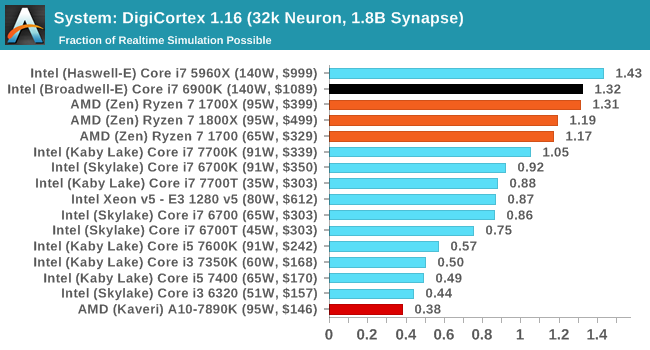
Agisoft Photoscan 1.0
Photoscan stays in our benchmark suite from the previous version, however now we are running on Windows 10 so features such as Speed Shift on the latest processors come into play. The concept of Photoscan is translating many 2D images into a 3D model - so the more detailed the images, and the more you have, the better the model. The algorithm has four stages, some single threaded and some multi-threaded, along with some cache/memory dependency in there as well. For some of the more variable threaded workload, features such as Speed Shift and XFR will be able to take advantage of CPU stalls or downtime, giving sizeable speedups on newer microarchitectures.

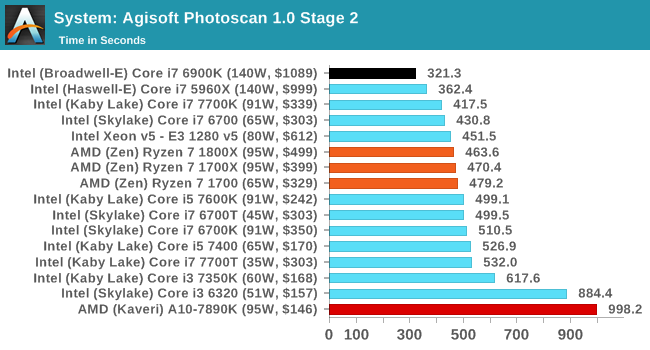
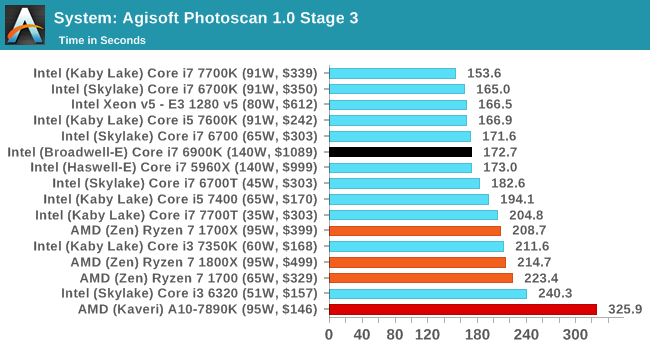
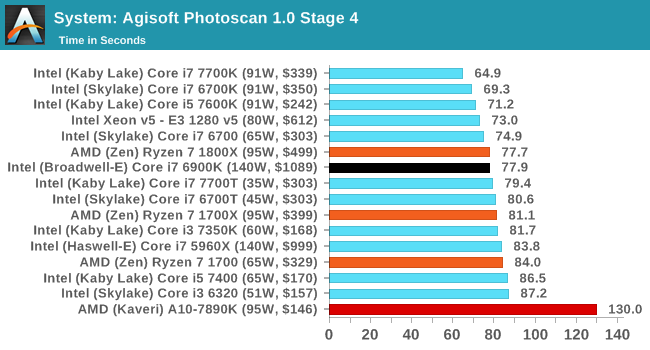
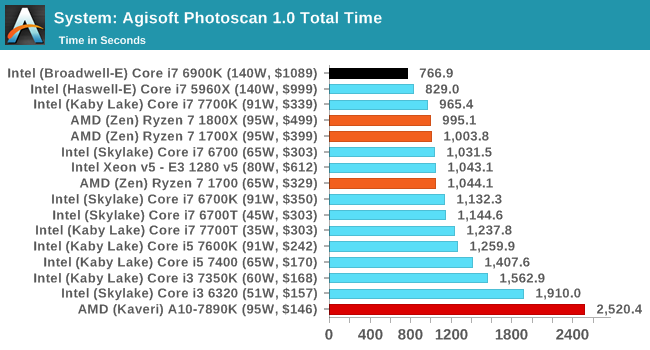










574 Comments
View All Comments
mikeZZZ - Friday, March 3, 2017 - link
Anadtech, can we please run closer to real life scenarios such as a gaming benchmark with a file compression benchmark running at the same time. Even gaming enthusiasts run more than one program at a time. For example, file decompression in the background while playing a game, or baseball game streaming in a small window while playing a game. You already have many individual benchmarks, so why not go the extra but significant benchmark of running two? We know this favors the higher core CPUs (maybe even Ryzen 7 1700 over all other lower core ones CPUs) but that is closer to real life and should be very meaningful to someone wanting to make an informed purchase.ValiumMm - Saturday, March 4, 2017 - link
Would also like to see thisUrQuan3 - Friday, March 3, 2017 - link
Just want to put out a quick comment about benchmarking with Handbrake. In dealing with Broadwell-E, and especially ThunderX, I've found that Handbrake often doesn't scale well past about 10 cores, and really doesn't scale well past 16 or so. What seems to happen is that the single-threaded parts of Handbrake tend to dominate the encode time. In extreme cases, ultra-fast and placebo will take almost the same amount of time as x264 is consuming input faster than the rest of Handbrake can generate it. On ThunderX, I've found I can complete four 1080p placebo encodes in the same amount of time that I can complete one. I would expect a similar result on a 48 core Intel, though I do not have access to one beyond 24 cores. Turbo boost would hide this effect a bit.I am not knocking using Handbrake for benchmarking. The Handbrake and ray-trace results are the two that I care about most. I just thought I'd give a heads up about this limitation. You can check CPU usage statistics to get an indication of when you are running up against this limit.
Oh, and I am very excited to see multiple ray-tracers in your runs. Please continue.
Meteor2 - Saturday, March 4, 2017 - link
Presumably though you can have several x264 jobs running simultaneously on that hardware? So while your time to encode a certain piece doesn't decrease, you have more total-throughput (e.g. encoding several different bitrates for adaptive streaming). Should give good efficiency too on a larger Broadwell-E or a ThunderX.UrQuan3 - Tuesday, March 7, 2017 - link
Exactly. It's the first time I've thought about installing a queue manager for a single computer.jade5419 - Saturday, March 4, 2017 - link
I agree with this. In my experience Handbrake has a core / thread limit.I have a Z600 system with dual Xeon 5570 @ 2.93GHz, 6 core / 12 threads (total 24 threads), 48GB of RAM and a Z620 system with dual Xeon E5-2690 @ 2.9GHz 8 core / 16 threads (total 32 threads), 64GB RAM.
The two systems transcode video at the same speed using Handbrake 1.0.3. Monitoring CPU usage shows all threads of the Z600 at 100% utilization whereas the CPU utilization on the Z620 is approximately 80%.
Notmyusualid - Sunday, March 5, 2017 - link
Ever tried running GTA5 on 28 cores?It doesn't work. You have to adjust the game 'launchers' core affinity to < 26 cores or it won't even load.
Given this discovery, I expect there are many more applications out there, that may crap-out as we see more and more cores come into the mainstream.
Just a thought.
mapesdhs - Sunday, March 5, 2017 - link
I'd love to know why this happens. I'm guessing something dumb within Windows.Outlander_04 - Friday, March 3, 2017 - link
There is more than enough good news to make me want to buy a 6 core Ryzen when they become available .Likely that will be the sweet spot for gamers
0ldman79 - Saturday, March 4, 2017 - link
I'm looking forward to seeing Ryzen updated in the bench.There aren't any apps or benchmarks that cross over between the FX series and the Ryzen series, so we can't do any side by side comparison.
Great review guys. Looking forward to the six core Ryzen. I think just like the FX series the six core will be the sweet spot.